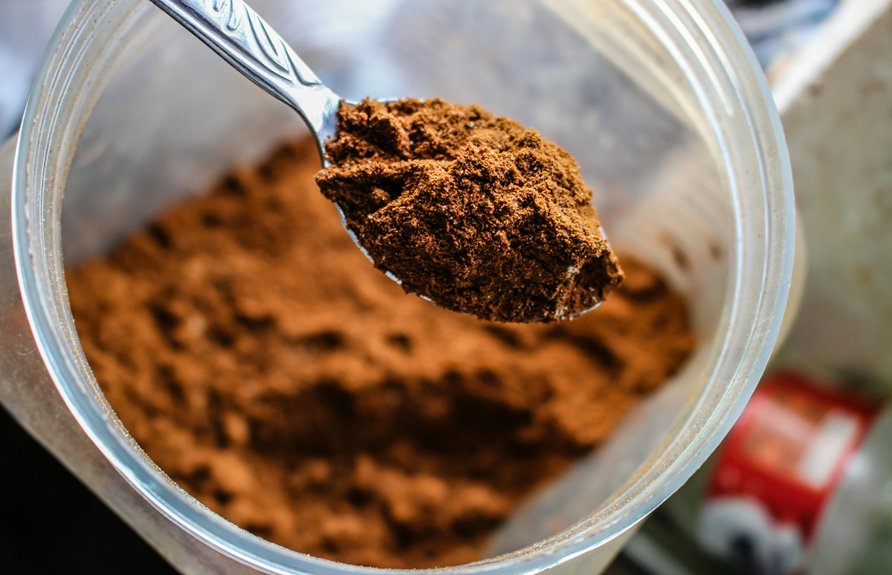You’d think that baking powder and bicarbonate of soda are interchangeable, but that couldn’t be further from the truth. These two ingredients play distinct roles in baking, and knowing how they function is essential for your recipes. What if you could elevate your baked goods just by understanding these differences? Let’s explore the unique properties of each and how to use them effectively.
Key Takeaways
- Baking powder contains an acid, a base, and a filler, whereas bicarbonate of soda is solely sodium bicarbonate (a base).
- Baking powder activates without additional acids, while bicarbonate of soda requires acidic ingredients to produce carbon dioxide.
- Baking powder is versatile for recipes without acids, while bicarbonate of soda is best for recipes containing acidic components.
- Each ingredient affects the final product differently; baking powder creates lighter baked goods, while bicarbonate of soda results in denser textures.
- Baking powder and bicarbonate of soda are not interchangeable; understanding their distinct functions is essential for successful baking.
Understanding Baking Powder
When you bake, understanding the role of baking powder is essential for achieving the desired texture and rise in your baked goods. This leavening agent combines an acid and a base, typically cream of tartar and bicarbonate of soda, activating when wet and heated.
Mastering baking techniques means knowing how to balance ingredient ratios, as too much baking powder can lead to a bitter taste and excessive rise, while too little can result in dense, flat outcomes.
Always measure accurately and adjust your recipe accordingly to guarantee your cakes, biscuits, and breads rise perfectly, creating the ideal crumb and texture every time.
Understanding Bicarbonate of Soda
Bicarbonate of soda, or baking soda, has a distinct chemical composition that sets it apart from baking powder.
You’ll find it commonly used not just in baking but also in cleaning and deodorising applications.
Understanding its role in baking, especially in comparison to baking powder, is essential for achieving the desired results in your recipes.
Chemical Composition Differences
Although often used interchangeably in baking, baking powder and bicarbonate of soda differ markedly in their chemical composition.
Bicarbonate of soda, or sodium bicarbonate, has a simple chemical structure (NaHCO₃) and acts as a base. Its acidity levels are low, requiring an acid for activation, which releases carbon dioxide during cooking.
In contrast, baking powder contains sodium bicarbonate along with an acidifying agent and a moisture-absorbing compound. This combination allows it to react independently in recipes, producing carbon dioxide without needing an external acid.
Understanding these differences is essential for achieving the desired texture and flavour in your baked goods.
Common Uses Explained
While many people may not realise it, bicarbonate of soda serves a variety of essential functions in cooking and baking. As a leavening agent, it reacts with acidic ingredients to produce carbon dioxide, helping your baked goods rise.
It’s also a versatile cleaning agent, effective for removing stubborn stains and odours. When using bicarbonate of soda, keep in mind common baking tips, like ensuring it’s fresh for best results.
For ingredient storage, seal it tightly in a cool, dry place to maintain potency. This simple ingredient can enhance both your culinary creations and household tasks efficiently.
Baking Applications Comparison
When it comes to baking, understanding the distinct roles of baking powder and bicarbonate of soda is essential for achieving the desired outcomes in your recipes.
Each ingredient interacts differently with other components, affecting your baking techniques and ingredient ratios. Here are three key differences to keep in mind:
- Leavening Power: Bicarbonate of soda requires an acid to activate, while baking powder contains its own acid.
- Flavour Impact: Bicarbonate can produce a slightly bitter taste if overused, whereas baking powder is typically neutral.
- Texture Differences: Bicarbonate creates a denser crumb, while baking powder leads to lighter, airier baked goods.
The Chemical Reactions Involved
Understanding the chemical reactions involved in baking powder and bicarbonate of soda (bicarb soda) reveals why they’re not interchangeable despite their similar purposes in baking. Bicarb soda, a pure base, reacts with acids to produce carbon dioxide, creating leavening. In contrast, baking powder contains both an acid and a base, activating when mixed with moisture and heat. Here’s a comparison:
| Component | Reaction Type |
|---|---|
| Bicarb Soda | Acid-base reaction |
| Baking Powder | Double reaction (acid/base) |
| pH Level | Alkaline |
| Carbon Dioxide | Produced by both |
| Activation | Requires acid (bicarb) |
When to Use Baking Powder
When you’re baking, understanding the composition of baking powder helps you choose the right leavening agent.
Typically, baking powder contains both an acid and a base, which activate when mixed with moisture and heat, making it ideal for recipes like cakes and muffins.
If a recipe specifically calls for baking powder, it’s essential to use it to achieve the desired rise and texture.
Baking Powder Composition
Baking powder is an essential leavening agent in many recipes, consisting of a combination of an acid, a base, and a moisture-absorbing agent.
Understanding its composition helps you choose the right baking powder type based on acidity levels. Here are three key components:
- Acid: Commonly cream of tartar or citric acid, providing the necessary reaction when combined with the base.
- Base: Usually sodium bicarbonate, which reacts with the acid to produce carbon dioxide.
- Moisture-absorbing agent: Typically starch, preventing premature reactions before baking.
Recipes Requiring Baking Powder
While many recipes might call for bicarbonate of soda, you’ll find that baking powder is essential for achieving the desired rise and texture in certain baked goods. Common baking powder recipes include fluffy pancakes and light cakes, where the leavening action is vital. When you don’t have baking powder, consider using substitutes like a combination of bicarbonate of soda and cream of tartar or yoghurt. Here’s a quick comparison:
| Baking Powder Recipes | Baking Powder Substitutes |
|---|---|
| Pancakes | Bicarbonate of soda + cream of tartar |
| Cakes | Bicarbonate of soda + yoghurt |
| Muffins | Bicarbonate of soda + vinegar |
When to Use Bicarbonate of Soda
Although you might think of bicarbonate of soda as just another raising agent, its unique properties make it essential in various baking scenarios.
Bicarbonate of soda is more than a raising agent; its unique properties are vital for successful baking.
Here are some key usage guidelines to contemplate:
- Acidic Ingredients: Use it when your recipe contains acidic components like yoghurt, buttermilk, or vinegar, as bicarbonate benefits from these reactions to create lift.
- Quick Breads: Opt for it in quick breads and muffins for a fast rise without waiting for yeast.
- Browning: Utilise it in biscuits for a deeper flavour and colour, enhancing the Maillard reaction.
Understanding these applications guarantees you maximise its effectiveness in your baking endeavours.
Can They Be Substituted for Each Other?
Could you substitute baking powder for bicarb soda in your recipes?
While both serve as leavening agents, they aren’t directly interchangeable due to their different compositions. Baking powder contains both an acid and a base, while bicarb soda is purely a base.
If you’re considering substitution, keep ingredient compatibility in mind. You’ll need to adjust for the acid in your recipe if you choose to use bicarb instead of baking powder.
For effective results, follow substitution tips carefully, understanding that using too much or too little can affect your dish’s texture and flavour.
Tips for Successful Baking with Both Ingredients
To achieve the best results when baking with both baking powder and bicarbonate of soda, you need to understand how each ingredient interacts with others in your recipe.
Mastering these baking techniques will enhance your creations. Keep the following tips in mind:
- Balance Ingredient Ratios: Use 1/4 teaspoon of bicarbonate of soda for every teaspoon of baking powder to maintain proper leavening.
- Acidic Ingredients: Pair bicarbonate of soda with acidic components like yoghurt or vinegar for ideal reactions.
- Timing Matters: Mix wet and dry ingredients just before baking; the sooner you bake, the better the rise.
Utilise these strategies for success!
Conclusion
In the world of baking, baking powder and bicarbonate of soda are like two dancers in a carefully choreographed performance, each playing a unique role. Understanding their distinct functions helps you achieve the perfect rise and texture in your baked goods. While they can’t always be swapped, knowing when to use each ingredient is key to a successful recipe. Embrace their differences, and you’ll create delicious results that rise to the occasion every time.

